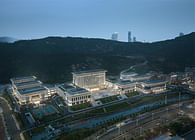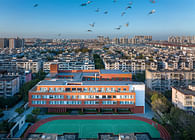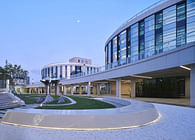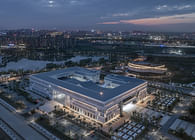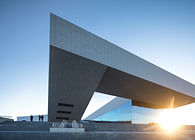
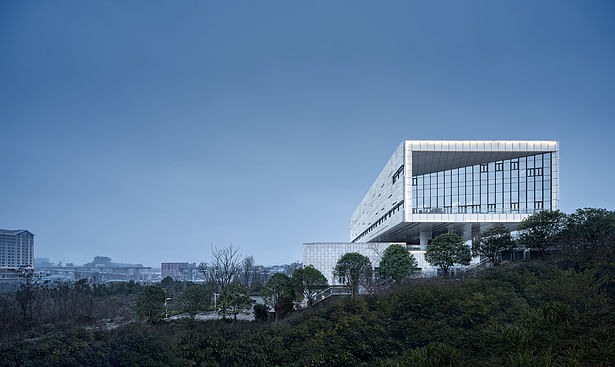
Site Overview
The Chinese Culture (Publishing and Broadcasting) Data Industry (CCDI) project is the first national-level data center in China's news, publishing and broadcasting industry. It is located in Guizhou Shuanglong Airport Economic Zone in Guiyang City. Upon completion, it will become the country's largest platform for copyright trading, as well as the largest hub for innovative broadcasting and television networks clusters. Reaping the benefits of Guizhou Province’s geography, climate and natural resources, the park is driven by industrial policies, oriented towards big data and cloud computing industries, and strategized to drive the development of the national economy. Its goal is to create a dynamic, complex, open and ecological big data platform.
As the first project launched in the CCDI Industrial Park, the Copyright Cloud Headquarter has multiple missions: to build two national-level databases ‒ for copyright information and copyright comparison, to impose multi-dimensional monitoring and tracking of cultural content posted online, and to create a whole-industry-chain service platform that integrates the certification, monitoring, and transaction of digital content.
The building is located in the critical phase I area of the park, near the intersection of Xingye West Road and Southwest Ring Road of the Shuanglong Airport Economic Zone. The project benefits from the site’s convenient location and ecological surrounding. Across the street sits the Shuanglong Airport Economic Zone Planning Exhibition Hall, while creative tourism projects such as the Colorful Guizhou Cultural and Creative Park and the Colorful Guizhou City are in the immediate vicinity. The site’s original topography is a 15-meter (max.) north-facing slope. The land area is approximately 7,500 square meters. The building has 3 floors above ground and 2 floors underground, with an above-ground floor area of 4462 square meters. The height of the building is 18.6 meters.
Design Concept
The architectural form is developed from the concept of a suspended "smart information box". The volume creates a dialogue with the site’s topography using the form of Guizhou's unique stilt houses and shaping floor levels in accordance with the slope. The floor plans of second and third floor are rectangular, so as to frame the clean massing of a "smart information box". The structure spans 30 meters between the building’s west part and the two stilts on the east that lift it from the slope, making the "smart information box" look suspended above the undulating topography. The underground volume is designed to echo the floating box while being coherent with the terrain. On the north elevation, white stone claddings are used on the curtain wall to outline the main entrance and “the window” in the northwest corner, echoing the box above.
On the other hand, the design highlights modernity and the sense of technology in shaping the "big data box’s" visual experience. The "information box" is made of glass curtain walls, with the east and west walls slightly set back to represent digital "windows". Aluminum louvres are used on the north and south façade to represent the rhythmic, spontaneous code of the big data. On the top of the south façade, a droplet-shaped concave is designed to give the building a sense of vigor.
Program Organization
The building is stepped from south to north and divided into two parts ‒ above ground and underground. The west part of the building is stilted, freeing the first floor to form an open entrance plaza, on which a ring road leads to the main entrance of the exhibition hall. Linked by the escalator, the first and second floors are both exhibition spaces for big data and the Copyright Cloud. On the building’s north side, there is an elevator hall entrance that leads directly to the copyright trading hall, monitoring display hall, hosting center and office spaces on the third floor. The service entrance is on the east side of the building.
The lower part of the building conforms to the topography and is partially buried underground on the south side, which mainly serves as facility space for fire control an electricity. The north side is exposed and open, within which the two floors serve as service spaces for the office, such as the canteen and the kitchen. Large steps are set up on the east and west sides of the building for pedestrian and emergency evacuation.
Green Space ‒ Vertical Design
Taking topography, cost, and maintenance into consideration, the landscape is designed in a vertical manner both along the road and within the site. For example, native plants are planted on the steps beside the basement, while the plaza is designed with paving, vegetation, flower beds, etc., submerging the architecture in nature and creating a poetic ecological urban landscape. An open ground and a vigorous building figure is hidden amid mountains, gazing at the city from afar.
Benefitting from the city's geography, industrial policy and other advantages, the Copyright Cloud Headquarter endeavors to represent the concepts of intelligence, digitalization, and ecology with architectural design, and to create a vital, complex, open, and ecology-driven big data display platform to eventually safeguard the functioning of the modern and intelligent information network infrastructure.
Status: Built
Location: Guizhou, CN
Firm Role: architectural design
Additional Credits: Construction: Shanghai HuaDu Architecture and Urban Design Company (HDD)
Project Location: Guiyang, Guizhou Province, China
Chief Designer: Kuang Xiaoming
Architectural Design: Shen Yi, Zhang Haiao, Shi Feng, Yao Qiwei, Gong Benling, Chen Xiaotong
Structural Design: Zhang Yongqiang, Pu Yiyi, Zhu Yuehai, Zhou Zhen, Wang Guoxun
Electrical Design: Zhang Yi, Chen Yu, Xiao Yan, Ren Fusheng
Water Supply and Drainage Design: Jiang Yi, Wu Wenwen, Yang Cheng
HVAC Design: Cheng Lingsong, Chai Yunliang, Qu Dongyang, Dong Yunfeng, Yang Chao
Floor Area: 9767㎡
Project Year: 2018
Photograph: Zhang Yong

